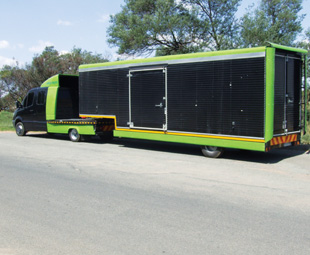Wind deflectors: do they really work?

Do wind deflectors that are fitted to trucks and trailers actually save fuel? Or are they simply marketing gimmicks? VIC OLIVER puts a Mercedes-Benz Sprinter coupled to a 14-metre pantechnicon type semi-trailer – with and without a full aero kit fitted to the truck tractor and trailer – to the test.
I conducted two identical 130 km trips with the Sprinter/semi-trailer combination. The first was run with a full aero kit fitted to the truck tractor and trailer, which included a number of wind deflector components:
• A cab-mounted roof deflector kit. The kit was custom made to fit the cab’s roof, which resulted in a very smooth air flow stream to the roof height of the trailer
• Side chassis panels were fitted to the truck tractor
• Cab extenders were fitted behind the cab to reduce the cab gap to a minimum
• Full trailer chassis skirts and a nose cone were fitted
• A top and two side deflectors were added at the rear. This was done in order to draw air into the vacuum caused at the back of the trailer when the vehicle is moving.
It must be noted that the rear side trailer wind deflectors can only be fitted if the trailer is not already at the maximum permissible width.
With the full custom-made aero kit fitted to the truck and trailer, the vehicle was extremely streamlined, reducing the drag factor on the unit.
The test route was from Johannesburg, travelling south along the N1 highway to the Parys turn off and then returning on the same route in a northerly direction.
On the first test run with the full aero kit fitted to the vehicle and trailer, the wind was extremely strong. It was blowing in a northerly direction, which resulted in a strong tail wind on the outbound trip and a head wind on the return trip.
Surprisingly, no vehicle instability or buffeting was experienced when driving directly into the strong headwind on the return leg of the test. This was obviously due to the wind deflectors, which created a smooth air flow over the entire vehicle.
On the first test run, we achieved a fuel consumption of 13,97 l/100 km.
On the second day, we covered the exact same test route. But this time all the aero kit components were removed.
The weather was much calmer on the second day, with very little head wind. The fuel consumption achieved over the second run (running the vehicle at the same speed and using the same driving style as the first test run) was recorded at 16,41 l/100 km.
The fuel saving with the vehicle fitted with the full aero kit was therefore 2,44 l/100 km – or 14,8%.
To evaluate the potential cost savings afforded by the aero kit, we compared the initial cost of the full truck and trailer aero kits to the savings that could be achieved using the aero kits. The cost of the full truck tractor and trailer aero kits is R28 500. The saving in fuel with the vehicle fitted with the kits is 2,44 l/100 km. This means 2,44 x R8,28 (the cost of diesel per litre), or R20,20 per 100 km travelled.
This means that the initial cost of the full kit could be recovered within the first 141 089 km.
Does this mean that wind deflectors are a prudent investment? Certainly. In my opinion, the fitment of aero kits makes sense in operations where the vehicles cover 50 000 km or more a year. Aero kits are especially beneficial when used on vehicles with large frontal areas.
With the cost of fuel today and the highly competitive road freight rates, saving fuel should be a priority in any road freight operation. Of course, road freight operators also have a responsibility to reduce their carbon footprint by using less fuel.
Published by
Focus on Transport
focusmagsa



